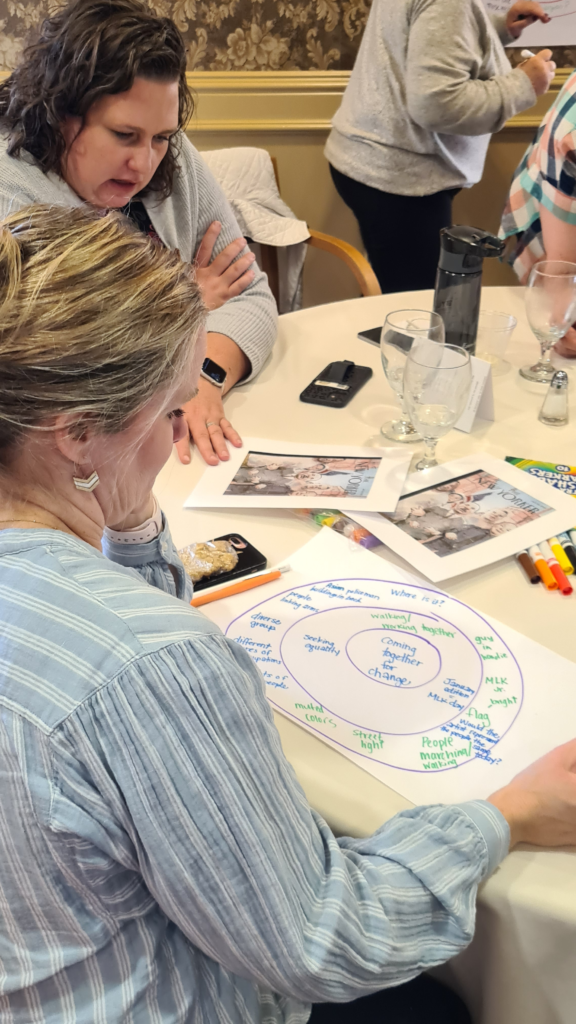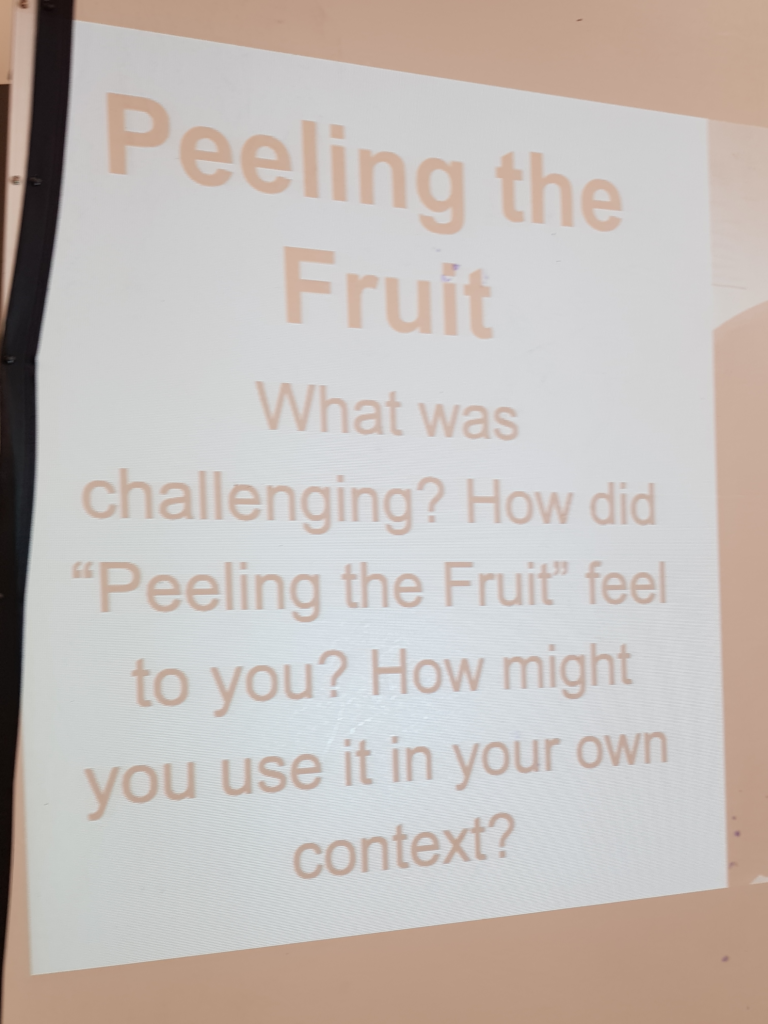My Learning Journey with “Peeling the Fruit”:
Modeling Thinking Routines in Professional Development Settings
This blog post was written by Jim Reese, Director of the Professional Development Collaborative at Washington International School
What is “Peeling the Fruit,” you might be asking? For those who don’t know, it’s a thinking routine, developed at Project Zero, in the Visible Thinking project. You’ll also see it referred to as “Peel the Fruit.”
(Just like other thinking routines, Peeling the Fruit is a pedagogical tool that aims to elicit and develop a particular kind of thinking, or thinking disposition, that leads to deeper understanding of a given topic. Thinking routines are designed to have only a few steps; they are engaging for students and easy to use and remember; and they are meant to be routinized, i.e., used over and over again in order to hone that targeted thinking disposition.)
In this piece, I want to share some lessons I’ve learned from facilitating Peeling the Fruit with different groups of educators, with the hope that there’s relevance for classroom use as well.
You can read about the purpose of Peeling the Fruit and directions for use here, on the Project Zero website. Its goal is to make visible the progress over time of one’s (or a group’s) thinking about a given topic. It can be adapted flexibly. In the classroom, students can return to their initial Peeling the Fruit as they continue exploring the topic, or they can use it as a guide the next time they engage with the routine.
While I never had the chance to use Peeling the Fruit when I was teaching English at the middle or high school levels, I was inspired by high school English and French literature teachers at Washington International who were using it in powerful ways with their students. Since then, I’ve seen it adapted across grade levels and subject areas. Over the last few years, I’ve modeled it frequently in professional development workshops.



Adaptations for Educator Workshops
In PD Collaborative workshops, we always aim to put participants in the shoes of learners–feeling what students might feel when, say, encountering new content, or trying on a thinking routine or protocol for the first time. There’s a certain kind of positive energy I notice in adult learners when they are given the opportunity to think deeply and make sense of a complex image or idea, and then are asked to think about application in their own context.
I have adapted Peeling the Fruit when I use it with teachers because I am usually modeling it in a one-off setting, whereas in a classroom it should fit into a larger unit of study or topic under consideration. In a workshop, I must fit the whole process into one session and I need the flexibility of using stand-alone examples as the focus, instead of connecting thoughtfully to an ongoing exploration.
Given the limited time in a professional development workshop, I prefer to use art as the content to make sense of in the moment. It’s efficient and often accessible in that one can jump right in and start noticing what’s there. If anyone in the group has low vision or blindness, it’s not too difficult to adapt–someone could describe orally without interpretation details in the artwork, or the facilitator could bring in an art object that can be handled.
Lately, I’ve employed Peeling the Fruit with three powerful images: Autorretrato en la frontera entre México et los Estados Unidos (Self-Portrait on the Border Between Mexico and the United States) by Frida Kahlo; a New Yorker magazine cover by Barry Blitt titled The Dream of Reconciliation (after Steve Schapiro’s iconic photograph from the Selma-to-Montgomery march of 1965); and Kehinde Wiley’s Napoleon Leading the Army over the Alps (after Jacques-Louis David’s Napoleon Crossing the Alps). All three artworks are rich in detail and complexity, resistant to an easy interpretation. As we begin the routine, I ask participants to consider what the artwork is saying to them.


The steps I follow are:
Step 1: Slow Looking
We look closely at whatever it is under consideration–a text, an image, a short clip from a video, etc. (In my version, each group is given a reproduction of one of the aforementioned works.) I introduce the idea of exploring and tracking our emerging understanding of a topic, idea or thing, and arriving at a core meaning.
The “slow looking” piece (note that it could be slow reading or listening as well) allows us to ease into the topic at hand. I ask participants to work on their own first, coming up with what they’re noticing, before I ask them to form small groups for the routine itself. I might bring in a thinking routine such as Looking 10×2 or See-Think-Wonder to guide the noticing.
Step 2: Sharing & Recording on the Outer Layer of the Fruit
After forming small groups, I introduce the routine and give instructions step-by-step. Early on in using the thinking routine, when I gave the three steps all at once, I noticed that the first step was often rushed. Not many details were listed before the group moved on to making connections, building explanations, or trying to understand context. By taking each step in turn, the groups tend to slow down, and I am able to encourage those who might not be capturing enough detail to keep looking. Remember that one of key aims of the routine is to make an individual’s or group’s thinking visible; therefore, being able to see the movement from noticing to making meaning is vital.
Each group receives chart paper and markers, someone draws on the paper a big fruit with a core at its center. I ask them to discuss what each person is noticing and to list those details around the outer layer, or skin, of the fruit.
I want group members to share freely, most especially when they are in the noticing phase, as what one person notices might not necessarily be something another person in the group noticed. As they discuss their noticings and list them on chart paper, my hope is that they are sharpening their observational skills, are curious about what others paid attention to, and are open to revising their thinking along the way. I often model these things as I listen in to group discussions. Using works that they most likely have little to no familiarity with gives them free rein to explore in a low-stakes environment. There are no right or wrong responses.
Step 3: Going Deeper, Beneath the Skin of the Fruit
When a good number of details have been recorded, the group then starts making connections, identifying patterns, juxtapositions, contradictions, etc. They are making sense of what they noticed. Perhaps there’s a need to consider context. Or build an explanation. These thoughts are recorded on the layer under the skin.
Step 4: Getting at the Core Meaning
Once the group has explored details and tried on explanations, it’s ready to take a stab at distilling the big idea or meaning. This should be written down on the core.
Step 5: Revising Our Thinking & Reflecting on the Process
I always want to give time for each group to share its thinking with another group, and then perhaps revise their thinking on the chart paper. I also want them to be able to articulate, either orally or in writing, their own process of making sense of something complex.
Once they’ve completed the routine, having groups pair up in order to share their thinking about the artwork they’ve explored helps them to understand that their thinking is still provisional. They haven’t received any background information about the artist or the artwork, but they’ve worked on gathering evidence to support their ideas about what the artwork is saying to them. Of course, classroom teachers would be linking the content to a larger lesson or unit objective. If there’s time in the workshop with teachers, I always want to have them reflect on and share with others how they might use Peeling the Fruit in their own context.
I always set aside a little time at the end to share some brief background information about each artwork; with the Wiley and Blitt pieces, there’s source material from which the work was appropriated. Below I’ve listed some helpful resources for all three works if you are interested in using them in class or in a workshop.


This deliberate step-by-step approach builds greater appreciation for the learning journey, not just the end point. In one workshop with principals, a participant commented, “I came to realize that getting it wrong was the most beneficial thing. Someone in our group suggested an interpretation that was quite solid, but we dismissed it as a group. Reflecting on how we need to consider various perspectives made me realize I have blind spots.”
Recently, in leading a workshop on “Peeling the Fruit” with these artworks, I noticed that a number of participants started searching on the internet for the source material or other tidbits to inform their understanding, before they’d finished with the routine. The Wiley or Blitt pieces were recognizable, perhaps, or they knew other self-portraits of Kahlo and wanted to find out more about her. My first reaction was to let it go. Some were merely verifying an instinct or zooming in on the piece in order to see more detail. But in some cases, I found that those who found background information on the artwork stopped trying to make meaning of it and simply took ideas from the internet source to formulate their core idea. I have since decided that it’s best to ask participants not to use their devices, only themselves as thinkers, as they make sense of the piece. Not getting to the “right” interpretation but finding joy and wonder in exploring something new is what Peeling the Fruit engenders.
On a final note, even though I’ve used the same works of art with Peeling the Fruit in a variety of settings with educators, each experience brings about something I didn’t anticipate–one of those constant sources of pleasures of teaching, whether in an English classroom or in a professional development setting. I want educators in the workshops I facilitate to not only develop the confidence to use thinking routines with learners, but also to think carefully about why they’re using the routine and what kind of thinking they hope to sharpen in their students. As I’ve learned from my colleagues Mark Church and Ron Ritchhart over the years, thinking routines, when used with intentionality, support the creation of a culture of thinking where everyone’s ideas matter and, I hope, where we all have a stake in sharpening the thinking of every member of the group.
(Special thanks to Angélica Guerrero, who inspired me to use the Frida Kahlo self-portrait, and to Gerald Smith, who introduced me to the Kehinde Wiley painting.)
Helpful Resources:
- The books Making Thinking Visible (by Ritchhart, Morrison, & Church), Creating Cultures of Thinking (by Ritchhart), and The Power of Making Thinking Visible (Ritchhart & Church) all are excellent for understanding both the value of thinking routines and the role they play in building a culture of thinking. The latter book has a rich description of Peeling the Fruit as well as examples of its use in the classroom.
- The Thinking Routines Toolbox features a variety of thinking routines developed by researchers working on multiple initiatives at Project Zero.
- Recent (April 2023) PBS NewsHour profile of Kehinde Wiley and an exhibition of his latest work at the deYoung Museum in San Francisco, CA
- An online article by Dr. Gayle Clemons about Kehinde Wiley and Napoleon Leading the Army over the Alps
- An online description of Frida Kahlo’s Autorretrato en la frontera entre México et los Estados Unidos
- An online New Yorker blurb explaining The Dream of Reconciliation by Barry Blitt